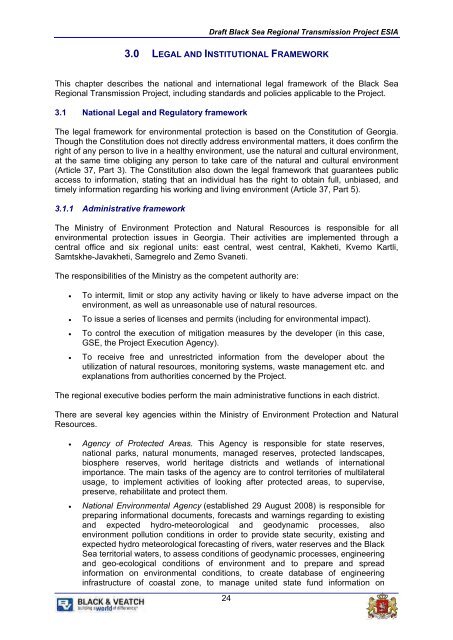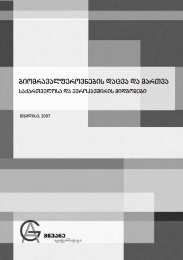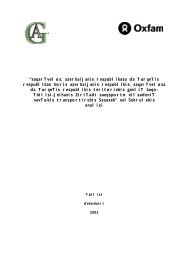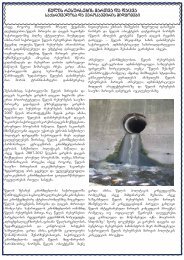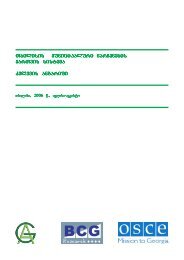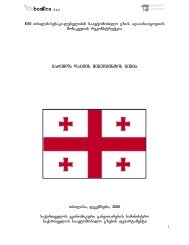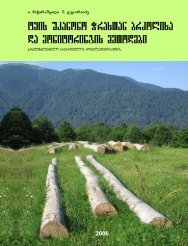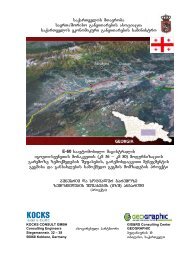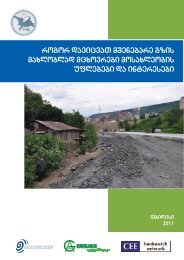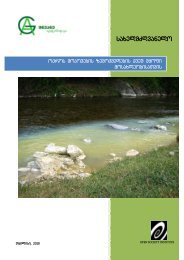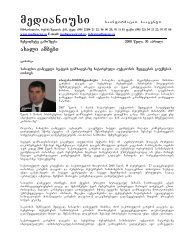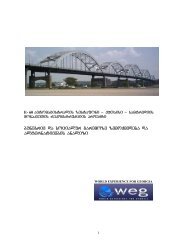Part I
Part I
Part I
You also want an ePaper? Increase the reach of your titles
YUMPU automatically turns print PDFs into web optimized ePapers that Google loves.
Draft Black Sea Regional Transmission Project ESIA<br />
3.0 LEGAL AND INSTITUTIONAL FRAMEWORK<br />
This chapter describes the national and international legal framework of the Black Sea<br />
Regional Transmission Project, including standards and policies applicable to the Project.<br />
3.1 National Legal and Regulatory framework<br />
The legal framework for environmental protection is based on the Constitution of Georgia.<br />
Though the Constitution does not directly address environmental matters, it does confirm the<br />
right of any person to live in a healthy environment, use the natural and cultural environment,<br />
at the same time obliging any person to take care of the natural and cultural environment<br />
(Article 37, <strong>Part</strong> 3). The Constitution also down the legal framework that guarantees public<br />
access to information, stating that an individual has the right to obtain full, unbiased, and<br />
timely information regarding his working and living environment (Article 37, <strong>Part</strong> 5).<br />
3.1.1 Administrative framework<br />
The Ministry of Environment Protection and Natural Resources is responsible for all<br />
environmental protection issues in Georgia. Their activities are implemented through a<br />
central office and six regional units: east central, west central, Kakheti, Kvemo Kartli,<br />
Samtskhe-Javakheti, Samegrelo and Zemo Svaneti.<br />
The responsibilities of the Ministry as the competent authority are:<br />
<br />
<br />
<br />
<br />
To intermit, limit or stop any activity having or likely to have adverse impact on the<br />
environment, as well as unreasonable use of natural resources.<br />
To issue a series of licenses and permits (including for environmental impact).<br />
To control the execution of mitigation measures by the developer (in this case,<br />
GSE, the Project Execution Agency).<br />
To receive free and unrestricted information from the developer about the<br />
utilization of natural resources, monitoring systems, waste management etc. and<br />
explanations from authorities concerned by the Project.<br />
The regional executive bodies perform the main administrative functions in each district.<br />
There are several key agencies within the Ministry of Environment Protection and Natural<br />
Resources.<br />
<br />
<br />
Agency of Protected Areas. This Agency is responsible for state reserves,<br />
national parks, natural monuments, managed reserves, protected landscapes,<br />
biosphere reserves, world heritage districts and wetlands of international<br />
importance. The main tasks of the agency are to control territories of multilateral<br />
usage, to implement activities of looking after protected areas, to supervise,<br />
preserve, rehabilitate and protect them.<br />
National Environmental Agency (established 29 August 2008) is responsible for<br />
preparing informational documents, forecasts and warnings regarding to existing<br />
and expected hydro-meteorological and geodynamic processes, also<br />
environment pollution conditions in order to provide state security, existing and<br />
expected hydro meteorological forecasting of rivers, water reserves and the Black<br />
Sea territorial waters, to assess conditions of geodynamic processes, engineering<br />
and geo-ecological conditions of environment and to prepare and spread<br />
information on environmental conditions, to create database of engineering<br />
infrastructure of coastal zone, to manage united state fund information on<br />
24


